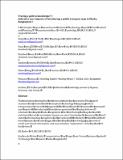Tracing a path to knowledge? Indicative user impacts of introducing a public transport map in Dhaka, Bangladesh
Author(s)
Zegras, P. Christopher; Eros, Emily; Butts, Kuan; Resor, Elizabeth; Kennedy, Stephen; Ching, Albert; Mamun, Muntasir; ... Show more Show less
DownloadZegras_Tracing a.pdf (1.064Mb)
OPEN_ACCESS_POLICY
Open Access Policy
Creative Commons Attribution-Noncommercial-Share Alike
Terms of use
Metadata
Show full item recordAbstract
The smartphone exemplifies the rhetorical smart city movement. This paper examines one potential use of smartphone technology—mapping public transportation services in a megacity of the Global South. We examine the potential user impacts of introducing a smartphone-generated and analogue-delivered schematic bus map in Dhaka, Bangladesh. After distributing the map, we used a web-based survey to investigate impacts on users’ knowledge, as measured by their stated understanding, navigation and perceptions of the system. While a small and biased sample, the results suggest that the map fills a knowledge gap, provides useful and valued information and may stimulate ‘exploration’ of the city and its bus system.
Date issued
2014-12Department
Massachusetts Institute of Technology. Department of Urban Studies and PlanningJournal
Cambridge Journal of Regions, Economy and Society
Publisher
Oxford University Press
Citation
Zegras, P. Christopher, Emily Eros, Kuan Butts, Elizabeth Resor, Stephen Kennedy, Albert Ching, and Muntasir Mamun. “Tracing a Path to Knowledge? Indicative User Impacts of Introducing a Public Transport Map in Dhaka, Bangladesh.” CAMRES 8, no. 1 (December 10, 2014): 113–129.
Version: Author's final manuscript
ISSN
1752-1378
1752-1386